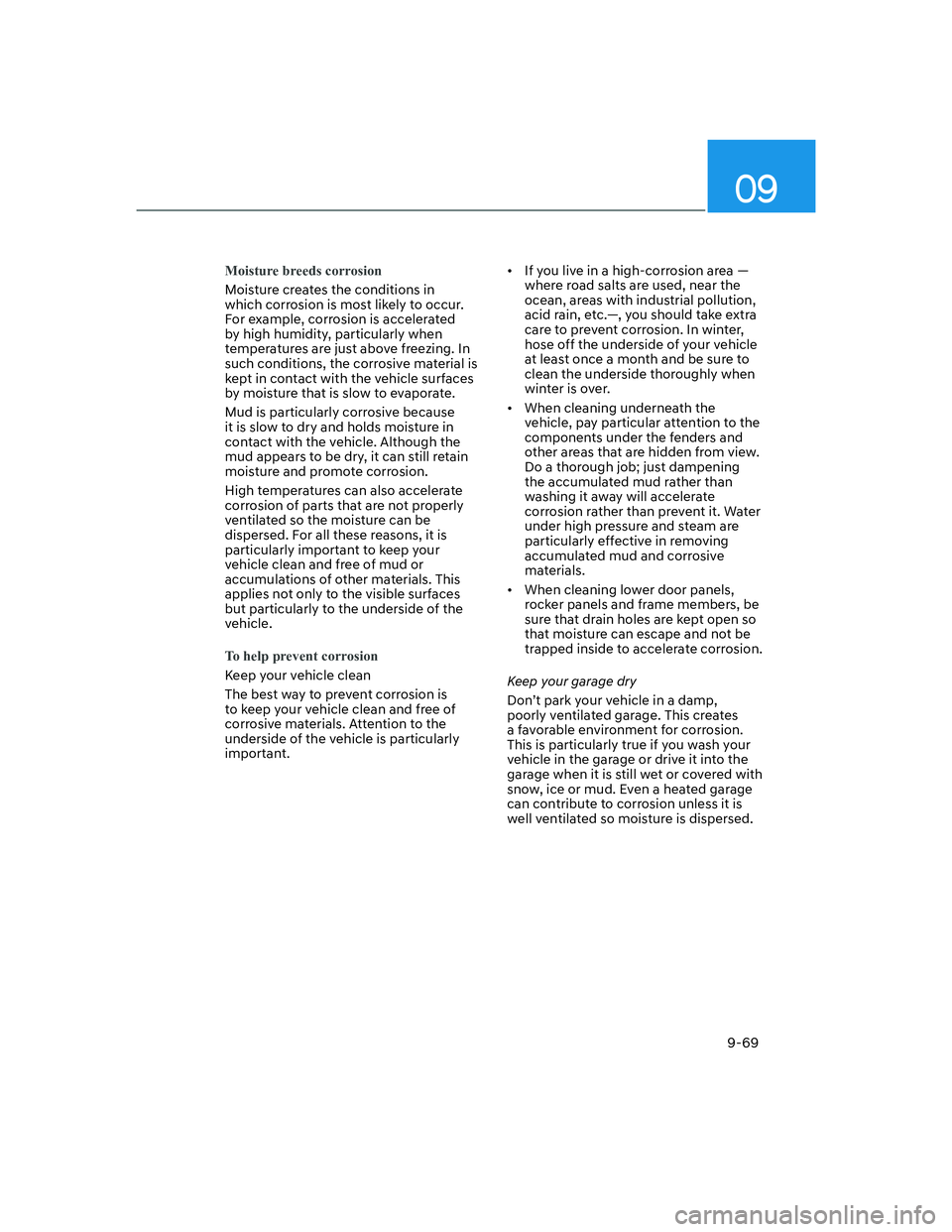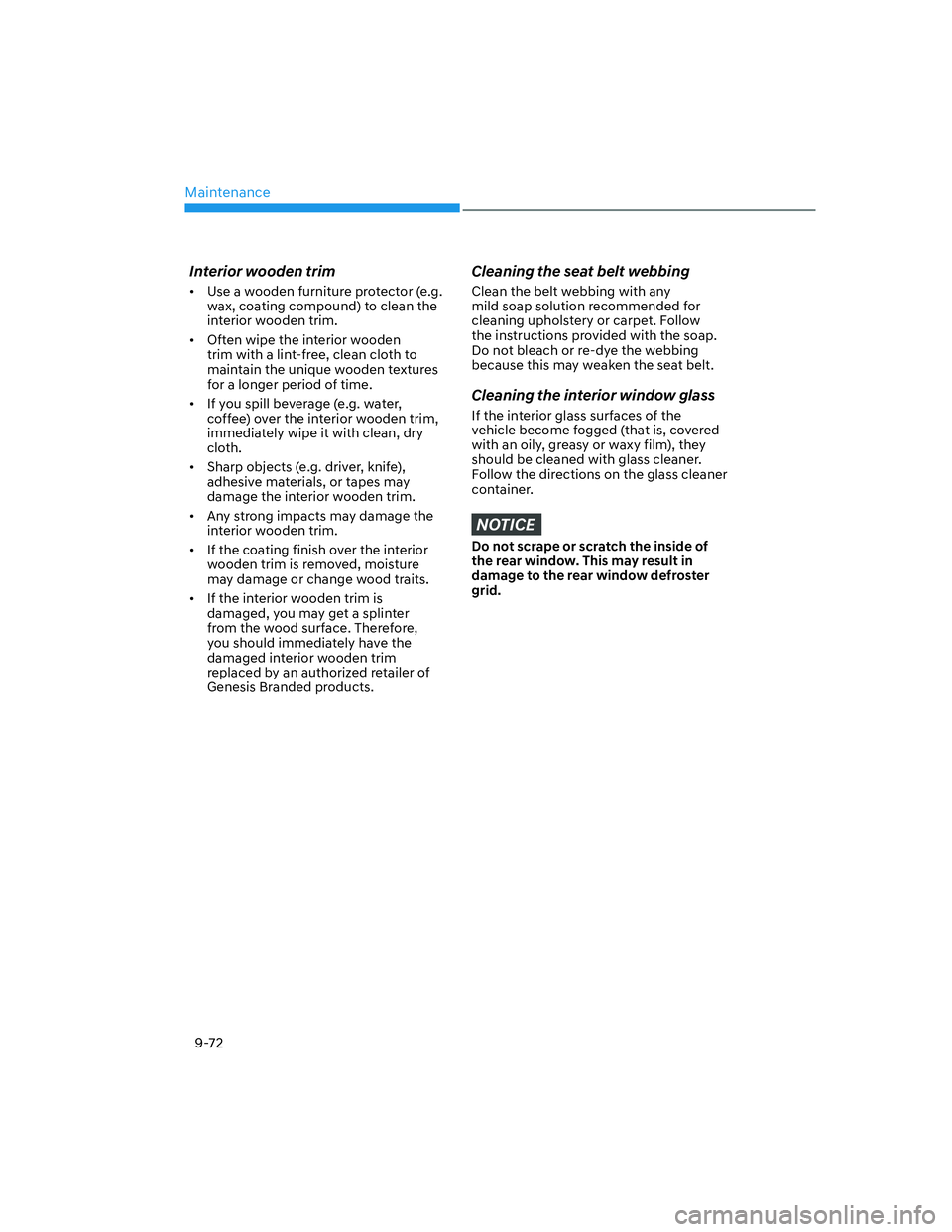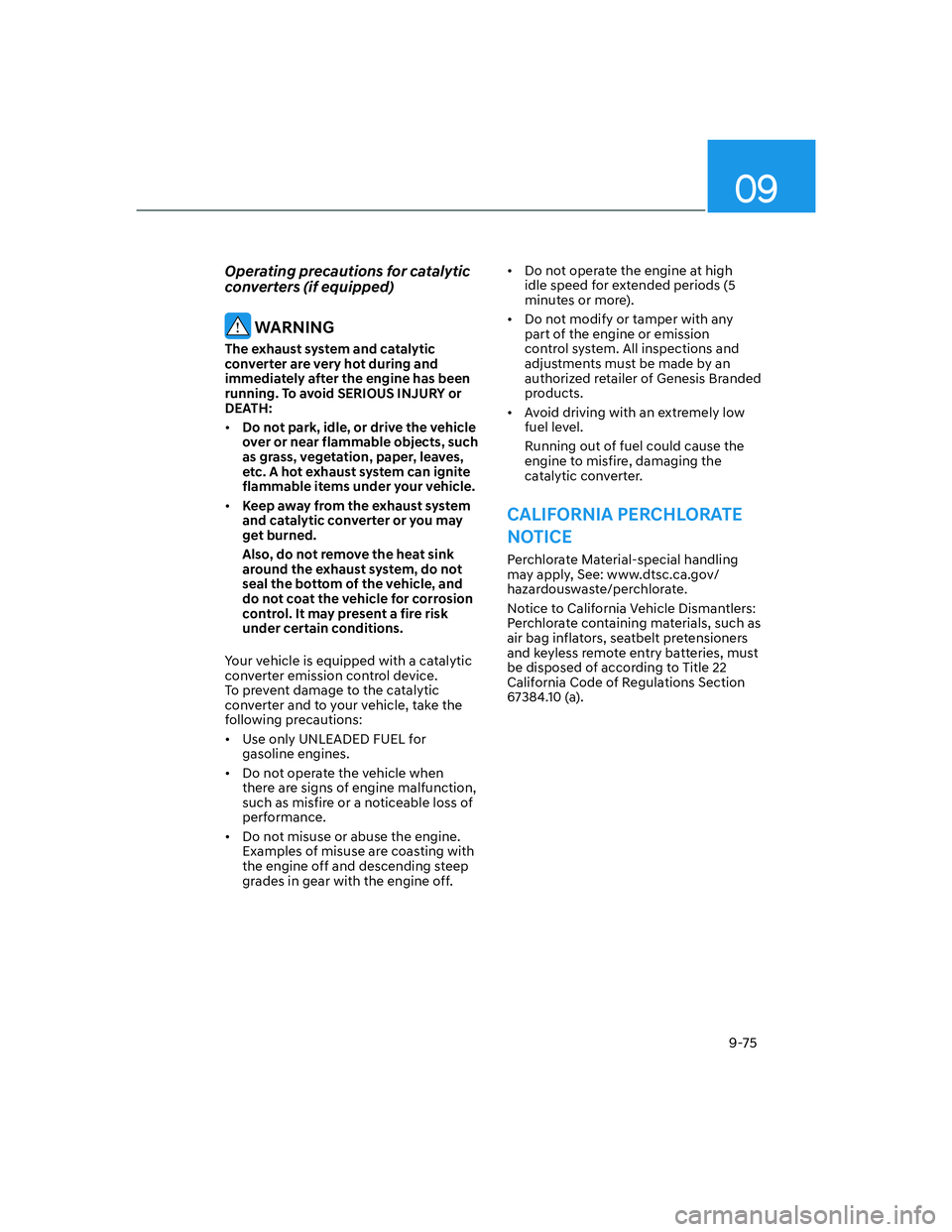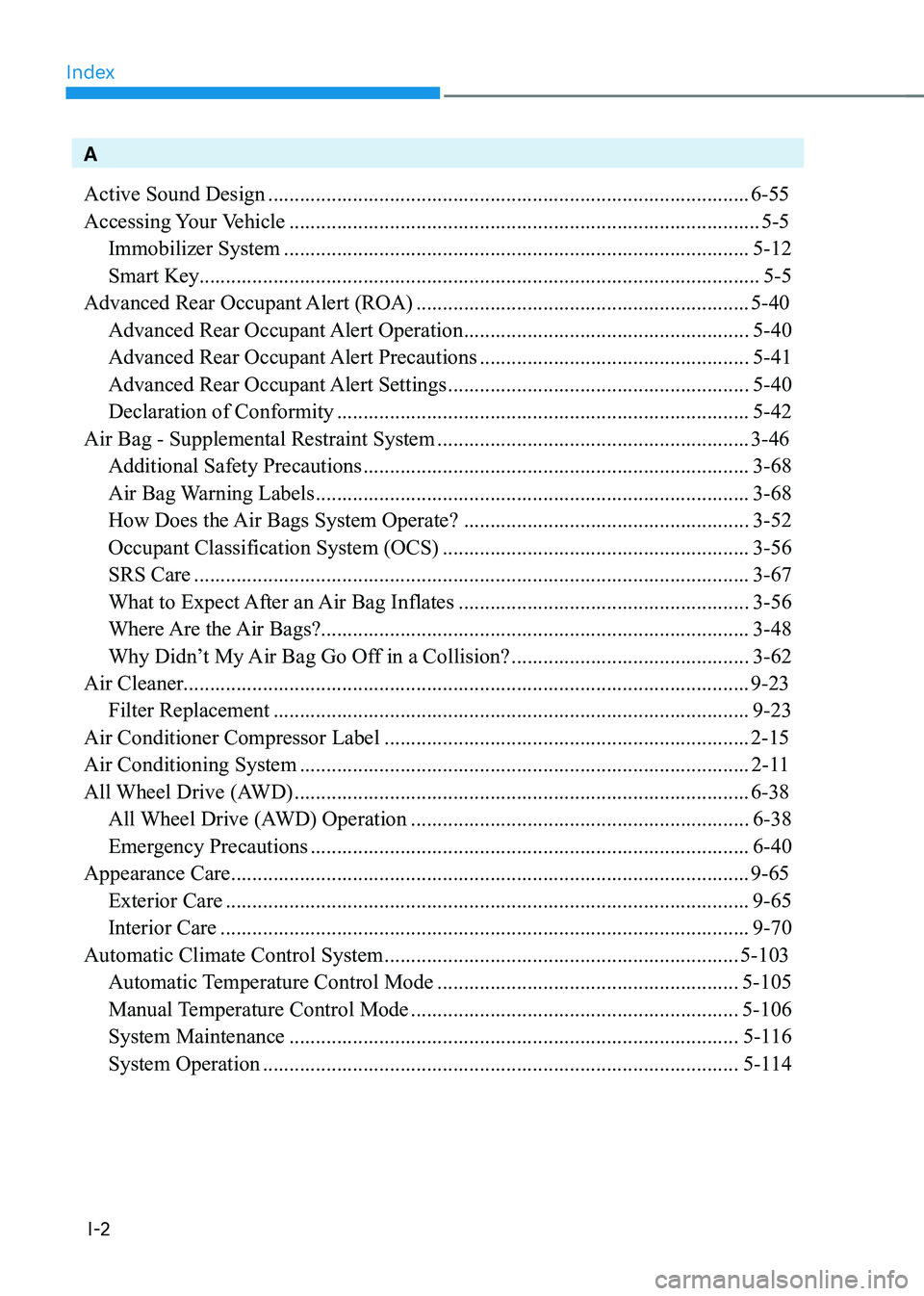2022 HYUNDAI GENESIS GV70 drive
[x] Cancel search: drivePage 607 of 647
![HYUNDAI GENESIS GV70 2022 Owners Manual Maintenance
9-50
Instrument panel fuse panel
Fuse Name SymbolFuse
RatingCircuit Protected
SUNROOFSUNROOF25A Sunroof Control Unit (Master)
P/SEAT
DRV1
P/SEAT
DRV125A[With IMS] Driver Power Seat Modul HYUNDAI GENESIS GV70 2022 Owners Manual Maintenance
9-50
Instrument panel fuse panel
Fuse Name SymbolFuse
RatingCircuit Protected
SUNROOFSUNROOF25A Sunroof Control Unit (Master)
P/SEAT
DRV1
P/SEAT
DRV125A[With IMS] Driver Power Seat Modul](/manual-img/35/56125/w960_56125-606.png)
Maintenance
9-50
Instrument panel fuse panel
Fuse Name SymbolFuse
RatingCircuit Protected
SUNROOFSUNROOF25A Sunroof Control Unit (Master)
P/SEAT
DRV1
P/SEAT
DRV125A[With IMS] Driver Power Seat Module
[W/O IMS] Driver Power Seat Switch
ECS
ECS15A ECS Unit
POWER
HANDLE
POWER
HANDLE15A Steering Tilt & Telescopic Unit
IBU1
IBU110AIBU, IAU, BLE Unit, Driver/Passenger Door Outside
Handle
MODULE14
MODULE1410AFront Corner Radar LH/RH, Rear Corner Radar LH/
RH, Head-Up Display, Smart Phone Wireless Charger,
Instrument Cluster, Front A/C Controller, Front
Console Keyboard, Rear A/C Controller
P/SEAT
DRV2
P/SEAT
DRV225A[With IMS] Driver Power Seat Module
[W/O IMS] Driver Power Seat Switch
P/SEAT
PASS1
P/SEAT
PASS1125A[With Walk In] Passenger Power Seat Module
[W/O Walk In] Passenger Power Seat Switch
S/HEATER
DRV
S/HEATER
DRV15A Driver Power Seat Module
S/HEATER
PASS1
S/HEATER
PASS115A Passenger Power Seat Module
DOOR
LOCK
DOOR
LOCK20ACenter Door Lock Relay, Center Door Unlock Relay, T/
Turn Unlock Relay
MODULE6
MODULE610AArmrest Lamp, IBU, IAU, Low DC-DC Converter, Rear
USB Charger, Electronic ATM Shift Lever Dial, E/R Sub
Junction Block (Power Outlet Relay)
BRAKE
SWITCH
BRAKE
SWITCH10A Stop Lamp Switch, IBU
Page 612 of 647
![HYUNDAI GENESIS GV70 2022 Owners Manual 09
9-55
Engine compartment fuse panel (Engine room sub junction block)
Type Fuse Name SymbolFuse
RatingCircuit Protected
SBPTC
HEATER1
PTC
HEATER130A [G4KR] PTC Heater 1 Relay
PTC
HEATER2
PTC
HEATE HYUNDAI GENESIS GV70 2022 Owners Manual 09
9-55
Engine compartment fuse panel (Engine room sub junction block)
Type Fuse Name SymbolFuse
RatingCircuit Protected
SBPTC
HEATER1
PTC
HEATER130A [G4KR] PTC Heater 1 Relay
PTC
HEATER2
PTC
HEATE](/manual-img/35/56125/w960_56125-611.png)
09
9-55
Engine compartment fuse panel (Engine room sub junction block)
Type Fuse Name SymbolFuse
RatingCircuit Protected
SBPTC
HEATER1
PTC
HEATER130A [G4KR] PTC Heater 1 Relay
PTC
HEATER2
PTC
HEATER230A [G4KR] PTC Heater 2 Relay
PTC
HEATER3
PTC
HEATER330A [G4KR] PTC Heater 3 Relay
INVERTER
INVERTER30A AC Inverter
WIPER FRT
WIPER
FRT30A Wiper Motor
IEB 3
IEB340A IEB Unit
POWER
OUTLET 1
POWER
OUTLET140A Power Outlet1 Relay
REAR
HEATED
REAR
HEATED40A Rear Heated Relay
IEB 1
IEB160A IEB Unit
IEB 2
IEB260A IEB Unit
BLOWER
BLOWER40A Blower Relay
MICROPOWER
OUTLET 2
POWER
OUTLET220A Luggage Power Outlet
A/C 2
A/C210A A/C Control Module
HEATED
MIRROR
HEATED
MIRROR10AFront A/C Controller, Driver/Passenger
Power Outside Mirror
POWER
OUTLET 3
POWER
OUTLET320A Front Power Outlet
Page 617 of 647

Maintenance
9-60
Consult an authorized retailer of
Genesis Branded products to replace
most vehicle light bulbs. It is difficult
to replace vehicle light bulbs because
other parts of the vehicle must be
removed before you can get to the bulb.
This is especially true for removing the
headlamp assembly to get to the bulb(s).
Removing/installing the headlamp
assembly can result in damage to the
vehicle.
WARNING
• Prior to working on a light, depress
the foot brake, shift to P (Park), apply
the parking brake, press the Engine
Start/Stop button to the OFF position
and take the key with you when
leaving the vehicle to avoid sudden
movement of the vehicle and to
prevent possible electric shock.
• Be aware the bulbs may be hot and
may burn your fingers.
NOTICE
Be sure to replace the burned-out bulb
with one of the same wattage rating.
Otherwise, it may cause damage to the
fuse or electrical wiring system.
NOTICE
To prevent damage, do not clean the
headlamp lens with chemical solvents
or strong detergents.
Information - Headlamp
desiccant (if equipped)
This vehicle is equipped with desiccant to
reduce fogging inside the headlamp due
to moisture. The desiccant is consumable
and its performance may change based on
the used period or environment. If fogging
inside the headlamp due to moisture
continues for a long time, consult an
authorized retailer of Genesis Branded
products.
Information
The headlamp and tail lamp lenses could
appear frosty if the vehicle is washed after
driving or the vehicle is driven at night in
wet weather. This condition is caused by
temperature difference between the lamp
inside and outside and, it does not indicate
a problem with your vehicle. When
moisture condenses in the lamp, it will be
removed after driving with the headlamp
on. The removable level may differ
depending on lamp size, lamp position
and environmental condition. However, if
moisture is not removed, have the vehicle
inspected by an authorized retailer of
Genesis Branded products.
LIGHT BULBS
Page 626 of 647

09
9-69
Moisture breeds corrosion
Moisture creates the conditions in
which corrosion is most likely to occur.
For example, corrosion is accelerated
by high humidity, particularly when
temperatures are just above freezing. In
such conditions, the corrosive material is
kept in contact with the vehicle surfaces
by moisture that is slow to evaporate.
Mud is particularly corrosive because
it is slow to dry and holds moisture in
contact with the vehicle. Although the
mud appears to be dry, it can still retain
moisture and promote corrosion.
High temperatures can also accelerate
corrosion of parts that are not properly
ventilated so the moisture can be
dispersed. For all these reasons, it is
particularly important to keep your
vehicle clean and free of mud or
accumulations of other materials. This
applies not only to the visible surfaces
but particularly to the underside of the
vehicle.
To help prevent corrosion
Keep your vehicle clean
The best way to prevent corrosion is
to keep your vehicle clean and free of
corrosive materials. Attention to the
underside of the vehicle is particularly
important.• If you live in a high-corrosion area —
where road salts are used, near the
ocean, areas with industrial pollution,
acid rain, etc.—, you should take extra
care to prevent corrosion. In winter,
hose off the underside of your vehicle
at least once a month and be sure to
clean the underside thoroughly when
winter is over.
• When cleaning underneath the
vehicle, pay particular attention to the
components under the fenders and
other areas that are hidden from view.
Do a thorough job; just dampening
the accumulated mud rather than
washing it away will accelerate
corrosion rather than prevent it. Water
under high pressure and steam are
particularly effective in removing
accumulated mud and corrosive
materials.
• When cleaning lower door panels,
rocker panels and frame members, be
sure that drain holes are kept open so
that moisture can escape and not be
trapped inside to accelerate corrosion.
Keep your garage dry
Don’t park your vehicle in a damp,
poorly ventilated garage. This creates
a favorable environment for corrosion.
This is particularly true if you wash your
vehicle in the garage or drive it into the
garage when it is still wet or covered with
snow, ice or mud. Even a heated garage
can contribute to corrosion unless it is
well ventilated so moisture is dispersed.
Page 629 of 647

Maintenance
9-72
Interior wooden trim
• Use a wooden furniture protector (e.g.
wax, coating compound) to clean the
interior wooden trim.
• Often wipe the interior wooden
trim with a lint-free, clean cloth to
maintain the unique wooden textures
for a longer period of time.
• If you spill beverage (e.g. water,
coffee) over the interior wooden trim,
immediately wipe it with clean, dry
cloth.
• Sharp objects (e.g. driver, knife),
adhesive materials, or tapes may
damage the interior wooden trim.
• Any strong impacts may damage the
interior wooden trim.
• If the coating finish over the interior
wooden trim is removed, moisture
may damage or change wood traits.
• If the interior wooden trim is
damaged, you may get a splinter
from the wood surface. Therefore,
you should immediately have the
damaged interior wooden trim
replaced by an authorized retailer of
Genesis Branded products.
Cleaning the seat belt webbing
Clean the belt webbing with any
mild soap solution recommended for
cleaning upholstery or carpet. Follow
the instructions provided with the soap.
Do not bleach or re-dye the webbing
because this may weaken the seat belt.
Cleaning the interior window glass
If the interior glass surfaces of the
vehicle become fogged (that is, covered
with an oily, greasy or waxy film), they
should be cleaned with glass cleaner.
Follow the directions on the glass cleaner
container.
NOTICE
Do not scrape or scratch the inside of
the rear window. This may result in
damage to the rear window defroster
grid.
Page 631 of 647

Maintenance
9-74
3. Exhaust Emission Control
System
The Exhaust Emission Control System is
a highly effective system which controls
exhaust emissions while maintaining
good vehicle performance.
When the engine starts or fails to start,
excessive attempts to restart the engine
may cause damage to the emission
system.
Engine exhaust (carbon monoxide)
precautions
• Carbon monoxide can be present
with other exhaust fumes. If you smell
exhaust fumes of any kind in your
vehicle, drive with all the windows
fully open. Have your vehicle checked
and repaired immediately.
WARNING
Engine exhaust gases contain carbon
monoxide (CO). Though colorless and
odorless, it is dangerous and could be
lethal if inhaled. Follow the instructions
on this page to avoid CO poisoning.
WARNING
CALIFORNIA PROPOSITION 65
WARNING
Engine exhaust and a wide variety of
automobile components and parts,
including components found in the
interior furnishings in a vehicle, contain
or emit chemicals known to the State
of California to cause cancer and
birth defects and reproductive harm.
In addition, certain fluids contained
in vehicles and certain products of
component wear contain or emit
chemicals known to the State of
California to cause cancer and birth
defects or other reproductive harm.
• Do not operate the engine in confined
or closed areas (such as garages) any
more than what is necessary to move
the vehicle in or out of the area.
• When the vehicle is stopped in an
open area for more than a short time
with the engine running, adjust the
ventilation system (as needed) to draw
outside air into the vehicle.
• Never sit in a parked or stopped
vehicle for any extended time with the
engine running.
• When the engine stalls or fails to
start, excessive attempts to restart
the engine may cause damage to the
emission control system.
Page 632 of 647

09
9-75
Operating precautions for catalytic
converters (if equipped)
WARNING
The exhaust system and catalytic
converter are very hot during and
immediately after the engine has been
running. To avoid SERIOUS INJURY or
DEATH:
• Do not park, idle, or drive the vehicle
over or near flammable objects, such
as grass, vegetation, paper, leaves,
etc. A hot exhaust system can ignite
flammable items under your vehicle.
• Keep away from the exhaust system
and catalytic converter or you may
get burned.
Also, do not remove the heat sink
around the exhaust system, do not
seal the bottom of the vehicle, and
do not coat the vehicle for corrosion
control. It may present a fire risk
under certain conditions.
Your vehicle is equipped with a catalytic
converter emission control device.
To prevent damage to the catalytic
converter and to your vehicle, take the
following precautions:
• Use only UNLEADED FUEL for
gasoline engines.
• Do not operate the vehicle when
there are signs of engine malfunction,
such as misfire or a noticeable loss of
performance.
• Do not misuse or abuse the engine.
Examples of misuse are coasting with
the engine off and descending steep
grades in gear with the engine off.• Do not operate the engine at high
idle speed for extended periods (5
minutes or more).
• Do not modify or tamper with any
part of the engine or emission
control system. All inspections and
adjustments must be made by an
authorized retailer of Genesis Branded
products.
• Avoid driving with an extremely low
fuel level.
Running out of fuel could cause the
engine to misfire, damaging the
catalytic converter.
CALIFORNIA PERCHLORATE
NOTICE
Perchlorate Material-special handling
may apply, See: www.dtsc.ca.gov/
hazardouswaste/perchlorate.
Notice to California Vehicle Dismantlers:
Perchlorate containing materials, such as
air bag inflators, seatbelt pretensioners
and keyless remote entry batteries, must
be disposed of according to Title 22
California Code of Regulations Section
67384.10 (a).
Page 634 of 647

Index
I-2
A
Active Sound Design ........................................................................\
...................6-55
Accessing Your Vehicle ........................................................................\
.................5-5
Immobilizer System ........................................................................\
................5-12
Smart Key........................................................................\
..................................5-5
Advanced Rear Occupant Alert (ROA) ...............................................................5-40
Advanced Rear Occupant Alert Operation ......................................................5-40
Advanced Rear Occupant Alert Precautions ...................................................5-41
Advanced Rear Occupant Alert Settings .........................................................5-40
Declaration of Conformity ........................................................................\
......5-42
Air Bag - Supplemental Restraint System ...........................................................3-46
Additional Safety Precautions ........................................................................\
.3-68
Air Bag Warning Labels ........................................................................\
..........3-68
How Does the Air Bags System Operate? ......................................................3-52
Occupant Classification System (OCS) ..........................................................3-56
SRS Care ........................................................................\
.................................3-67
What to Expect After an Air Bag Inflates .......................................................3-56
Where Are the Air Bags?........................................................................\
.........3-48
Why Didn’t My Air Bag Go Off in a Collision? .............................................3-62
Air Cleaner........................................................................\
...................................9-23
Filter Replacement ........................................................................\
..................9-23
Air Conditioner Compressor Label .....................................................................2-15
Air Conditioning System ........................................................................\
.............2-11
All Wheel Drive (AWD) ........................................................................\
..............6-38
All Wheel Drive (AWD) Operation ................................................................6-38
Emergency Precautions ........................................................................\
...........6-40
Appearance Care ........................................................................\
..........................9-65
Exterior Care ........................................................................\
...........................9-65
Interior Care ........................................................................\
............................9-70
Automatic Climate Control System ...................................................................5-103
Automatic Temperature Control Mode .........................................................5-105
Manual Temperature Control Mode ..............................................................5-106
System Maintenance ........................................................................\
.............5-116
System Operation ........................................................................\
..................5-114